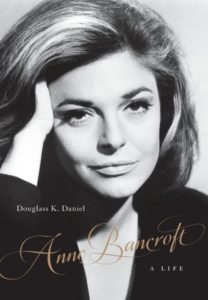As a movie fan and an aspiring filmmaker, I love reading books about old Hollywood. The main thing that makes Anne Bancroft: A Life, Douglass K. Daniel’s beautifully written new biography on the life of legendary actress Anne Bancroft, so fascinating is everything the reader learns about Bancroft and old Hollywood as a whole.
What I loved about this novel is how each page seems to bleed knowledge. For example, the book starts off with a short description about how the eras of World War II and the Great Depression were seen as the golden age of Hollywood. According to Daniel, humankind’s need to escape from the harsh reality of war resulted in the rise of Hollywood.
What Daniel means by this is that before World War II broke out, the Hollywood industry had not been doing so great. There were no breakout hits at the box office outside of the movies that had big Hollywood stars in them. Then, war broke out and suddenly business was booming in Hollywood, and everyone in it enjoyed a nearly four-year renaissance. Then the war ended, and this is where Bancroft’s career really started to pick up steam.
Bancroft’s first movie role was in Roy Ward Baker’s 1952’s psychological thriller Don’t Bother to Knock; after that, she had a string of glamorous supporting roles that won her critical acclaim. Suddenly, Bancroft was a star and there was no stopping her from reaching her full potential as one of Hollywood’s finest actresses. The details the book goes into while covering this make it a must read.
Another thing that I like about this book is Daniel’s clearly documented research of Bancroft’s career, from her early days to her romantic relationships with lawyer Martin May and Hollywood director and screenwriter Mel Brooks. My favourite part of the book is Daniel’s description of Bancroft’s experience of making what is considered to be one of the best comedies of all time, The Graduate.
In the book, Daniel describes an altercation between Bancroft and the film’s director, Mike Nichols. According to Daniel, the fight was about the now iconic “Mrs. Robinson, you’re trying to seduce me” scene. The script required Bancroft to wear nothing but a bra and a slip throughout the majority of the scene. The problem with this is Bancroft had always felt uncomfortable revealing any part of her body, so she protested this, and Nichols was forced to hire a double for the shots where the script required Bancroft’s character to be naked. It’s details like this that really makes the book interesting.
When it all comes down to it, Anne Bancroft: A Life is a great read for film lovers and will leave readers with plenty of new information that they will cherish long after the book’s concluding sentence.

